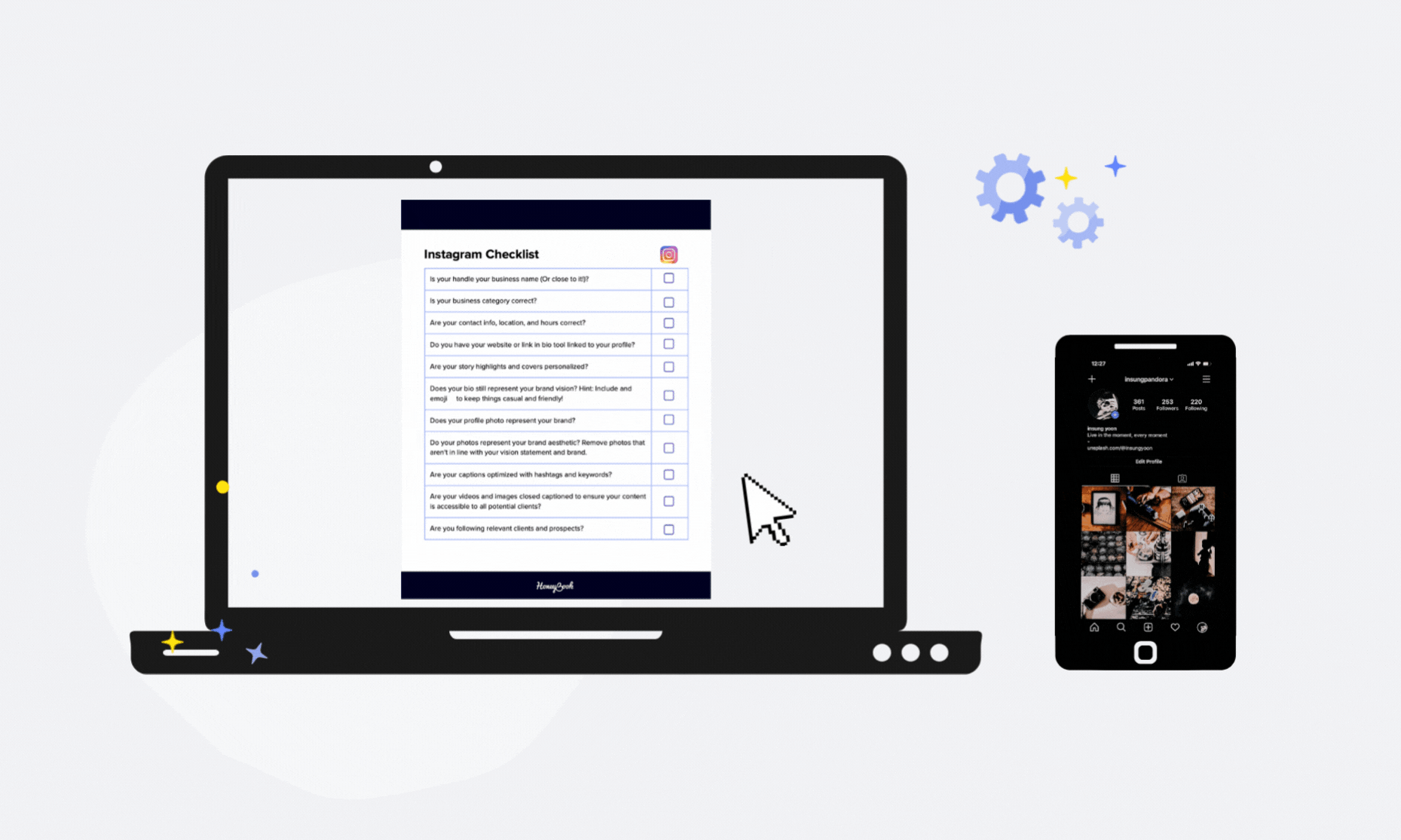You’re a savvy independent, but it’s easy to overlook the details. There’s no time like the present for an online marketing audit so that you’re ready to tackle the new year

This blog is part of our January Jumpstart series, our set of guides to help you freshen your strategy for 2025. Check out the other blogs in this series here.
When was the last time you read through your social media “about” section? Verified that all the links on your website still work? Checked the greeting message on your voicemail?
As a small business owner wearing a ton of different hats, it’s easy to “set it and forget it” after you create a strategy and materials for your different marketing channels. But this can be a huge detriment to your marketing’s effectiveness—and more importantly, your business.
Regardless of what industry you’re in, in today’s day and age, the competitive environment is constantly changing. So, it’s imperative, now more than ever, to refresh and audit your current marketing efforts and strategy on a regular basis to make sure that your marketing is successful, your marketing goals stay on track, your assets stay up-to-date, and your clients remain happy and satisfied.
This January, take the time to uplevel your current marketing efforts in 2025 with a comprehensive audit.
Here’s some key things to keep in mind:
- Make sure your branding is consistent
- Spruce up your social media profiles
- Test the links on your website and social media channels
- Audit your website SEO
- Alter your business description
- Listen to—and revamp—your voicemail greeting
- Increase your word-of-mouth presence
Make sure your branding is consistent
Your brand is what differentiates you from other businesses, anchors your business to an engaging image and color scheme, and creates a stable visual relationship between you and your target market. A stable, undeviating brand encourages client trust; it gives your brand an air of professionalism on first contact.
Make sure your branding is consistent
Your brand differentiates you from others, it anchors your business to a distinct image and color scheme, and creates a consistent visual relationship between you and your target audience.
A stable, undeviating brand is critical to an effective marketing strategy as it encourages client trust and gives your brand an air of professionalism on first contact.
What is a brand?
A brand comprises of:
- An outer personality, or your logo, typography, color palette, photography, and
- An inner personality, which includes your brand voice, vision, and values. Inner personality is understood through elements like your website text, social media captions, and more.
The intention of inspecting your brand in a marketing audit is to make sure the colors, fonts, and brand voice are the same throughout all your marketing materials. Look at your website, email newsletters, social media posts, business cards, rack cards, event flyers, ads, etc.
By ensuring that all your marketing materials and digital platforms adhere to your brand, you’ll not only build brand awareness and familiarity with your ideal customers, but be able to communicate your brand’s point of view and perspective clearly. A bonus: your business will also look striking and professional! platforms adhere to your brand, you build brand awareness and familiarity with potential customers. Your business will also look striking and professional!
If you are starting from scratch
One easy way to simplify your future marketing efforts and make your audit repeatable each year is by creating a brand guide. A brand guide is a (thorough) cheat sheet that contains the HEX codes of your brand color palette as well as font names.
If you worked with a graphic designer on your branding, they may have already sent you one. If not, it’s not too difficult to make one on your own with the materials you already have. Consider the psychology of a strong brand when pulling together your brand guide. Your goals are to:
- Choose colors that represent your brand’s personality and evoke mood and feeling
- Use words that inspire purchase that also fit your vibe check
- Use the above to create a sense of community a potential client desires to belong to
According to the University of Southern California, the psychological strategy of successful brands trends towards one of five core elements: excitement, competence, sincerity, sophistication, and ruggedness. Be mindful of these characteristics when creating your brand guide for the first time. Think about which word your brand aligns with most closely.
Need a little help? Download our brand guide worksheet below.
Update your social media profiles
There are so many components that make up your social media presence that it can be easy to overlook the small details. The accuracy of your information, hours, location, and contact information are especially important if you’ve made changes in your business.
Check the following sections on your social channels to be sure your work is up to date. Use a chart, like the following image, to stay organized.
Verify that your contact information is correct
Even if some of your contact information isn’t public, it’s wise to check that it’s up to date. Check the email address associated with your account and any customer-facing email addresses. Also look at your phone number, address, and business hours.
Refresh your bio
The bio (or about) section—no matter how short—can be a quick and easy marketing tactic that converts admirers into customers, or not. The standard formula is:
“I help [target market] with [their problem] by [your offer].” This is certainly effective, but you’re welcome to have fun and mix it up a bit. Just make sure your bio is clear. You can also use emojis for emphasis and to make scanning easier.
Use a photo of you or your logo as your profile picture
If you’re an independent and the face of your business, I recommend using a professionally shot picture of yourself that shows your brand colors. Make sure you’re looking right at the camera to build a connection with your target audience. Looking away from the camera can make you seem aloof.
If using your picture doesn’t compliment your brand, use your logo mark, which is the icon in your logo minus your business name.
It’s best not to change your profile picture too often, as it’s typically present next to every single post, comment, and interaction. Maintaining the same, on-brand profile photo or image is the foundation of building brand awareness on Instagram, TikTok, Pinterest, Facebook, and X (Twitter).

Optimize your website link in your social channels
As business owners, we’re often promoting multiple offers at a time. And that one “link in bio” isn’t going to cut it. Enter Linktree.
Linktree is a free service that allows you to create a page with numerous buttons. You’ll use your Linktree link in your Instagram, TikTok, Facebook, or Twitter bio’s website line and whenever someone clicks on it, they’ll be brought to multiple buttons to click on.
This allows you to link to multiple offers, blog posts, and other links.
You can also customize the look of your Linktree (to an extent). There is a paid version, but the free one is totally usable.
This tutorial will show you the ins and outs. Search your website provider (like Squarespace) then “custom Instagram linktree” for a tutorial specific to your website.
Customize your Instagram highlights covers
Highlights appear below your link in the bio and above your posts. They’re in the shape of a circle and you can click on each one (just like Stories) to see the collection of Stories classified as that Highlight.
You can update the thumbnail photo of your Highlights to be on brand. I recommend designing a custom graphic to maintain the branding of your Instagram account using Canva, a free cloud-based design software.
By creating a more visually compelling graphic, you’ll not only be able to make your Instagram page look more cohesive, you’ll increase social media engagement with your pinned highlights.
Head to Canva and create an Instagram Story canvas. On the left sidebar, you’ll see Templates. Type in Instagram Story Highlights Covers for a jumpstart.
What about your other social media profiles?
There are so many social profiles to update if only everything was in one place! We’ve created a social media checklist that will guide you in keeping your accounts up-to-date as you enter 2025 and beyond.
Test and update links on your website
Nothing is more frustrating than clicking on a dead link. Not only does it leave potential customers at a dead end, but it’s bad customer service. Having broken links can create a bad impression and be a deterrent for potential customers to want to work with you and create poor customer satisfaction for those who already do.
We recommend deadlinkchecker.com to verify that all the links on your website are in working order. It’s free!
Customize your 404 page
Create a custom 404 error page so that if someone lands on a broken link on your website, they’re not greeted with a boring — or even worse — frustrating string of error text. Even when pages or links don’t work, with a custom 404 page, you’ll still be able to maintain a seamless online presence and can also easily redirect website visitors to another part of your site.
If you designed your own website, search “custom 404 page” and your website platform, such as “Squarespace” for a tutorial.
Brush up on your User Experience (UX) writing
UX writing seems opaque, but it’s a skill anyone can gain with a little reading and practice. If you designed your own website, then you know navigation labels can be tricky. Here are some pointers for labeling your website navigation well:
- Know your audience and what they’re looking for. Each click means your reader is searching for the information behind that label. Understand your potential client’s intentions on your website, and write buttons that address that intent.
- Maintain a voice consistent with your brand personality . Nothing is more awkward than a beautiful website with poorly written navigation. Hire a copywriter with UX skills, if necessary.
- Keep it concise! The shorter the better. Write in plain English so your website is easy to understand.
- Use catchy call-to-actions. For example, “Begin Your Journey” is more enticing than “Buy Now.”
Perform an SEO audit
Search engine optimization (SEO) helps your website appear as close to the top of search results as possible. It’s very important in the context of your overall marketing strategy, but it’s hard to know where to get started.
If you’ve already set up the SEO on your website, running an SEO audit is key to maintaining your marketing goals. Critical things to do include:
- Checking to make sure that your keywords are still accurate for what you do.
- Double-checking that each page and post has metadata, including an optimized description and title.
Here’s some other things to keep in mind during the auditing process:
Page and site titles
When scanning your website, search engines prioritize your title tags, which are site titles, page titles, blog post titles, and headings on your actual website pages. Because these titles also appear in browser tabs, it’s essential that they contain the proper keywords.
Think about your website visitor (a potential client). What intention do they have to fulfill by looking at your site? Head to Google and plug that intention in. See what kinds of keywords crop up and if they overlap with those on your site. Decide on a key phrase that addresses search intent and is naturally repeatable in your website copy.
Website copy
The actual text on your website should include your relevant keywords along with the page name. Make sure to write as you normally would and incorporate keywords naturally. There’s no need for a bunch of unnecessary repetition.
Think about your brand voice and client intent, and write copy that speaks to client intention in your brand voice. Search engines prioritize sites that deliver quality information for the searcher. Make quality and thoroughness a priority over all else.
Footer
An often overlooked place to incorporate keywords is in your website footer. Because the footer appears on every single page of your website, it’s an absolute bang for your buck to include a line about your business.
Example: Miss MegaBug offers online business and marketing courses to female entrepreneurs who are just starting their businesses.
Always include your service location, if applicable.
Example: MegaBug Photography offers wedding photography in Littleton, NH as well as the White Mountains of NH area and beyond.
Meta descriptions
Meta descriptions allow you to add more information about your website and pages. While page and site titles are brief, a meta description can be up to 160 characters.
Not only do search engines scan your meta descriptions when determining if your website will appear in search results, potential visitors read them to determine if they actually want to visit your site.
Be sure to include keywords strategically but write your meta descriptions in cohesive sentences.
Image file names
What you name the photos you upload to your website matters. Be sure to title the image with the name of your website and relative descriptors, whether it’s the name of the page your photo is on, the blog post name, or the product.
Alternative text
Alternative text or alt text allows search engines to index images on a website and include them in search results. It appears in a box while hovering over an image or in place of an image if the image fails to load. Alt text is also relied on by the visually impaired.) Alt text is very specific. Be sure to describe the image’s subject and context, use keywords sparingly and refrain from starting your alt text with “picture of…” or “image of…”. Note that alt text is limited to 125 characters.
If you’re new to SEO, this guide will help you get started.
Alter your business description
Comb through your Facebook page, Google Business page, your website, Yelp, and anywhere else your hours are posted to verify that they’re up to date.
Listen to your voicemail greeting
This one is super easy to forget to check in on! If your voicemail greeting contains incorrect information or doesn’t reflect new changes to your business (i.e., how else to reach you or if your business name changed), be sure to re-record it.
Increase word-of-mouth marketing and reviews
The most effective form of marketing is referrals. Consider offering a discount or reward for customers when they refer your business to someone who then makes a purchase from you.
To increase your number of online reviews (which you can then use as testimonials on your website), post links to your profile on industry review sites like TripAdvisor, as well as your Google Business and Facebook pages. You can add these links to your website, wrap up emails to clients, social media, and more.
Double down on collabs and partnerships
If you’re collaborating with a brand that has a strong presence, tag, talk, and advertise it. Cross-advertising your brand generates community and strengthens inclusivity. Take advantage of the group effort you put in to create more word-of-mouth referrals.
Achieve marketing success with a comprehensive marketing audit
For any small business, making sure your marketing is refreshed and ready is key for long term success. At minimum we would recommend running a marketing audit on an annual basis and making it a key part of your marketing plan. And as your business matures and grows, moving from annual to more regular audits will ensure that your marketing initiatives remain successful and you’ll be able to achieve your business goals.
A marketing audit is just the tip of the iceberg when it comes to getting your business ahead in 2025. Be sure to check out our other January Jumpstart content for tips on small business finances, pricing, trends, and much more.

